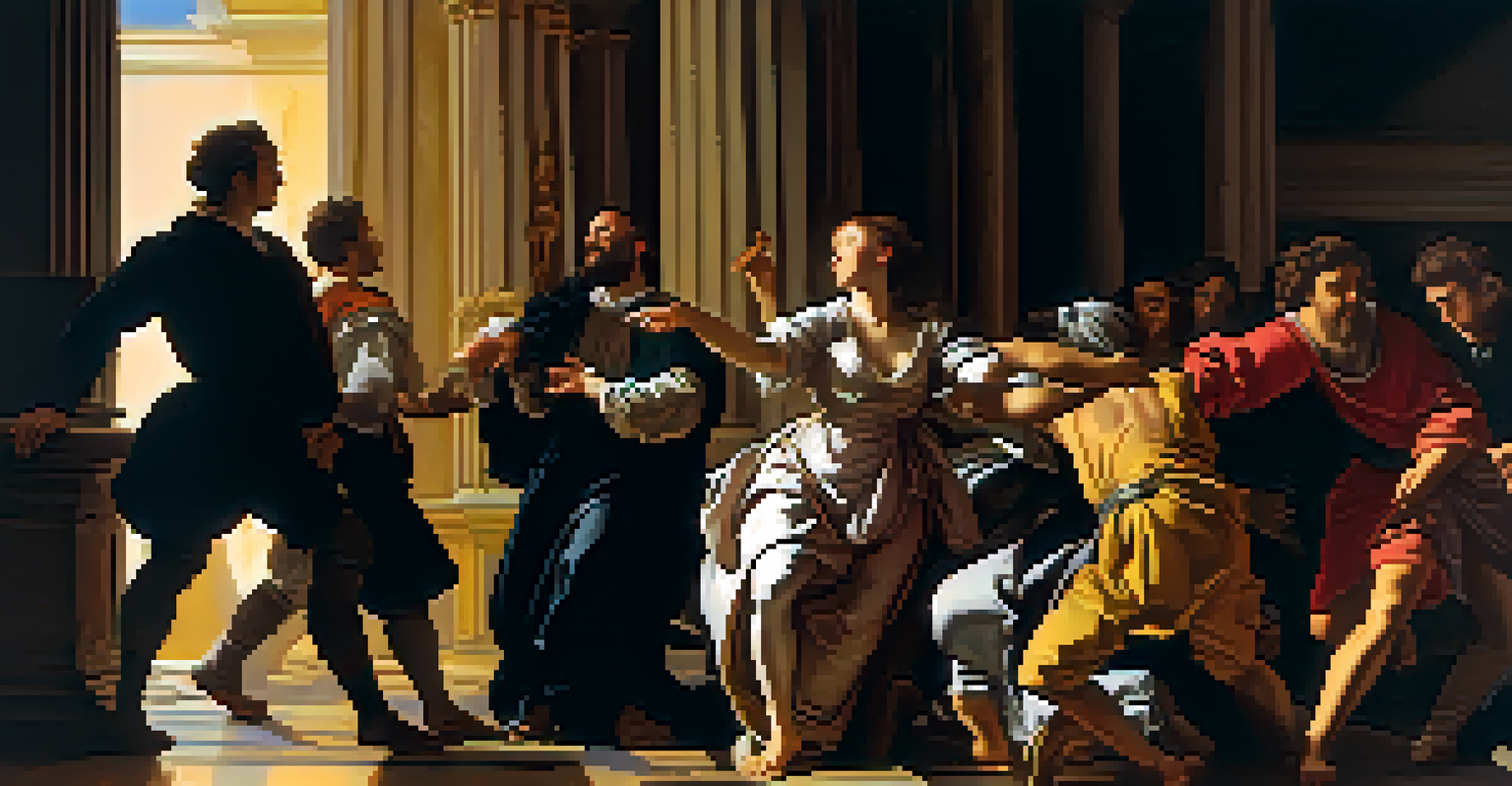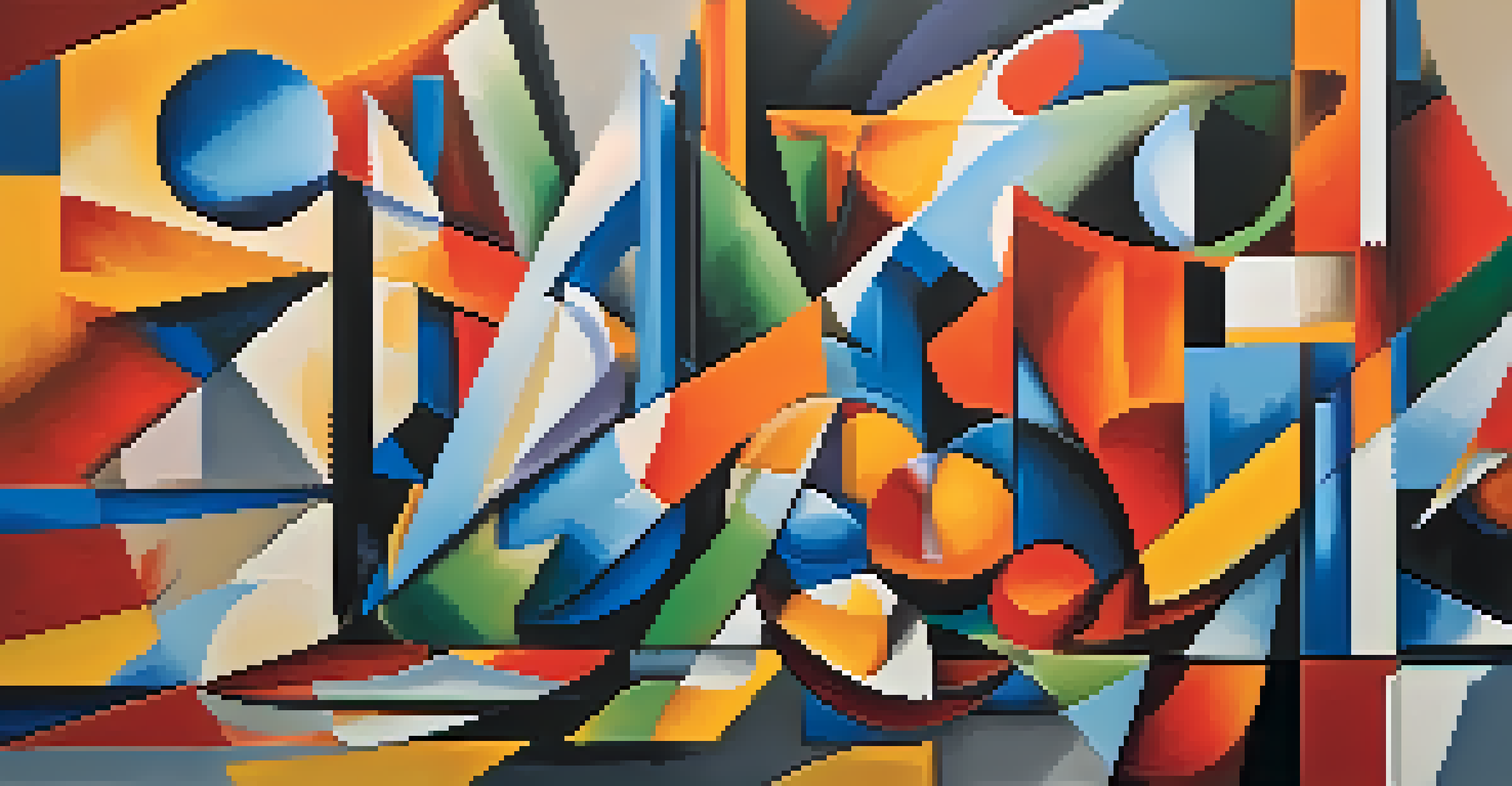The Evolution of Painting Techniques in Cultural Heritage

Understanding the Roots of Painting Techniques
Painting has been a fundamental form of expression for humanity, dating back to ancient times. Early techniques involved natural pigments and rudimentary tools, often reflecting the environment and culture of the time. For example, cave paintings from prehistoric eras used earth tones and animal fat, showcasing the early human connection to storytelling and identity.
Every artist dips his brush in his own soul, and paints his own nature into his pictures.
As civilizations advanced, so did their painting methods. Ancient Egyptians employed a complex system of hieroglyphs and vibrant colors to convey religious and cultural narratives. These early techniques laid the groundwork for future developments in painting, demonstrating how art can serve not only aesthetic purposes but also as a vehicle for communication and history.
Today, understanding these roots allows us to appreciate the diverse array of techniques that have emerged over the centuries. Each method tells a unique story about the culture and values of its time, reinforcing painting's role as more than just a visual art form but a vital part of human heritage.
The Renaissance: A Turning Point in Techniques
The Renaissance marked a significant shift in painting techniques, focusing on realism and human emotion. Artists like Leonardo da Vinci and Michelangelo pioneered methods such as chiaroscuro and sfumato, which added depth and dimension to their work. This period emphasized the study of anatomy and perspective, fundamentally changing how art was created and perceived.

One notable example is da Vinci's 'Mona Lisa,' where the use of soft transitions between colors creates a lifelike presence. This technique not only enhances the visual appeal but also engages viewers by evoking a sense of intimacy with the subject. Such innovations during the Renaissance laid the foundation for modern artistic practices.
Evolution of Painting Techniques
Painting techniques have evolved from ancient methods using natural pigments to modern digital approaches, reflecting cultural and societal changes over time.
The impact of these techniques extended far beyond their time, influencing countless artists and movements. The Renaissance taught us that art could be a powerful tool for exploring the human experience, a theme that remains relevant in cultural heritage today.
Baroque and the Rise of Emotion in Art
The Baroque period introduced a new level of emotional intensity in painting techniques. Artists like Caravaggio utilized dramatic contrasts of light and shadow to create dynamic compositions that captured the viewer's attention. This approach, known as tenebrism, was revolutionary in its ability to evoke emotion and draw the audience into the scene.
Art is the most beautiful of all lies.
Baroque paintings often featured grand themes, such as spirituality or human struggle, conveyed through expressive figures and vivid colors. For instance, in works like 'The Calling of Saint Matthew,' Caravaggio's use of light not only highlights the figures but also symbolizes divine intervention, enhancing the narrative's impact.
The Baroque era exemplifies how painting techniques can mirror cultural shifts and societal values. As emotions took center stage, art became a reflection of the complex human experience, further enriching the tapestry of cultural heritage.
Impressionism: Breaking Away from Tradition
The Impressionist movement of the late 19th century challenged traditional painting techniques by emphasizing the role of light and color over precise detail. Artists such as Claude Monet and Pierre-Auguste Renoir explored new ways to capture fleeting moments and the effects of natural light on their subjects. This shift marked a significant departure from the meticulous realism characteristic of earlier styles.
Monet's 'Impression, Sunrise' exemplifies this approach, where loose brushwork and vibrant colors create an ephemeral quality. This technique not only conveys the essence of the scene but also invites viewers to engage with the artwork on a personal level, evoking emotions tied to memory and perception.
Renaissance Redefined Art
The Renaissance introduced techniques like chiaroscuro and sfumato, emphasizing realism and human emotion, significantly transforming artistic expression.
Impressionism opened doors for future artistic movements, encouraging experimentation and individual expression. By breaking away from tradition, these artists reshaped the landscape of cultural heritage, emphasizing the importance of perspective and personal experience in art.
Modernism: Experimentation and New Media
Modernism brought an era of experimentation in painting techniques, with artists exploring abstraction and new media. Movements like Cubism, led by Pablo Picasso and Georges Braque, challenged conventional perspectives through fragmented forms and multiple viewpoints. This radical approach transformed how art was created and understood, prioritizing the artist's vision over realistic representation.
In addition to Cubism, the advent of new materials and techniques, such as acrylics and mixed media, further expanded the possibilities for artists. These innovations allowed for greater flexibility and expression, enabling artists to push boundaries and explore complex themes. For instance, Jackson Pollock's drip paintings exemplify this freedom of expression, emphasizing the act of painting itself.
The Modernist movement reshaped cultural heritage by redefining what art could be. It encouraged a dialogue about perception and reality, challenging audiences to engage with art in new and thought-provoking ways.
Cultural Heritage and Preservation of Techniques
As we reflect on the evolution of painting techniques, preserving these methods becomes crucial for cultural heritage. Many traditional techniques, such as fresco and tempera, are at risk of being lost due to modernization and changing artistic practices. Organizations and artists are working diligently to document and revive these techniques, ensuring that future generations can appreciate their historical significance.
For example, the revival of traditional fresco techniques showcases the dedication to maintaining cultural practices. Artists are not only recreating these methods but also adapting them to contemporary contexts, bridging the gap between past and present. This fusion of old and new emphasizes the continuity and relevance of cultural heritage in today’s art scene.
Future of Art and Technology
The future of painting techniques lies in the integration of traditional methods with digital tools, creating innovative art that honors cultural heritage.
Preserving these techniques allows for a richer understanding of our shared history and identity. By honoring the past, we can foster a deeper appreciation for the diverse tapestry of cultural heritage that continues to inspire artists around the world.
The Future of Painting Techniques in Cultural Heritage
Looking ahead, the future of painting techniques in cultural heritage is filled with possibilities. As technology evolves, artists are incorporating digital tools alongside traditional methods, creating a hybrid approach that reflects contemporary society. This blend of techniques allows for innovative expressions while honoring the historical roots of painting.
Moreover, the global exchange of ideas through the internet fosters collaboration among artists from diverse backgrounds. This cross-pollination of techniques enriches cultural heritage, as artists draw inspiration from various traditions, creating a dynamic and evolving art scene. For instance, digital art forms can coexist with traditional painting, offering new ways to engage with cultural narratives.

Ultimately, the evolution of painting techniques will continue to shape cultural heritage, reflecting societal changes and artistic innovation. Embracing this evolution ensures that art remains a vibrant and relevant part of our collective identity.